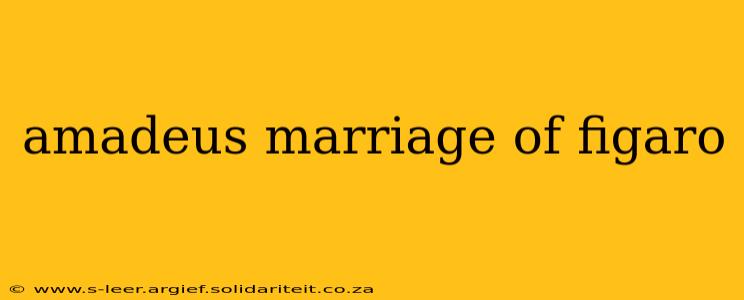Wolfgang Amadeus Mozart's The Marriage of Figaro is more than just an opera; it's a comedic masterpiece brimming with intricate plots, memorable characters, and a score that effortlessly blends beauty and wit. This exploration delves into Amadeus's unique interpretation of this iconic work, examining its enduring appeal and its continued relevance in the modern operatic landscape.
What makes Mozart's Marriage of Figaro so famous?
The enduring fame of The Marriage of Figaro stems from several key elements. Firstly, Mozart's score is undeniably brilliant. The melodies are instantly recognizable and utterly captivating, ranging from tender arias to boisterous ensembles. Secondly, the libretto, adapted from Beaumarchais's play, is full of witty dialogue, clever wordplay, and social satire that remains remarkably sharp even centuries later. The opera's exploration of themes such as love, marriage, class, and deception continues to resonate with audiences today. Finally, the opera's structure is masterful, seamlessly weaving together the numerous characters and subplots into a cohesive and satisfying whole. The comedic timing and dramatic tension are perfectly balanced, creating a truly captivating theatrical experience.
What is the plot of Mozart's Marriage of Figaro?
The opera revolves around the impending marriage of Figaro, the Count Almaviva's valet, and Susanna, the Countess's maid. Their plans are complicated by the Count's attempts to exercise his droit du seigneur, a feudal right allowing him to sleep with any woman on his estate before her husband. Figaro cleverly uses his own cunning and the Countess's wit to thwart the Count's plans, ultimately revealing his infidelity and forcing him to confront his own flaws. The opera is a whirlwind of mistaken identities, hidden rendezvous, and elaborate schemes, resulting in a satisfying resolution that celebrates love, fidelity, and the triumph of cleverness over arrogance.
What is the difference between Mozart's Marriage of Figaro and Beaumarchais's play?
While Mozart's opera closely follows the storyline of Beaumarchais's play, there are notable differences. Mozart's adaptation streamlines some of the plot points, focusing on the central conflict between Figaro and the Count. Certain characters are given more prominence, and the overall tone is perhaps a little lighter and more operatically dramatic than the original play. The musical setting, naturally, transforms the experience entirely, allowing for a greater exploration of the characters' emotions and motivations through the power of music.
How does Mozart's music contribute to the opera's success?
Mozart's music is integral to the opera's success. His melodies are memorable and expressive, perfectly capturing the emotions and personalities of the various characters. The ensembles are brilliantly crafted, enhancing the comedic and dramatic aspects of the plot. The use of orchestration is masterful, creating a rich and varied soundscape that supports the action on stage. The music moves seamlessly between moments of tenderness, humor, and dramatic intensity, reflecting the complexity of the characters and the situations they find themselves in.
What are the most famous arias in Mozart's Marriage of Figaro?
Several arias from The Marriage of Figaro have achieved iconic status. "Non più andrai" is a show-stopping baritone aria, showcasing Figaro's wit and triumph. The Countess's "Porgi amor" is a poignant and beautifully melancholic aria, expressing her sadness and longing. Susanna's "Deh vieni, non tardar" is a delightful and playful aria, highlighting her intelligence and charm. Each aria is perfectly tailored to the character and the dramatic situation, contributing to the overall emotional impact of the opera.
Amadeus's Marriage of Figaro is a testament to Mozart's genius, a work that continues to captivate audiences centuries after its premiere. Its enduring popularity is a testament to the power of its music, its clever libretto, and its timeless exploration of human relationships.
